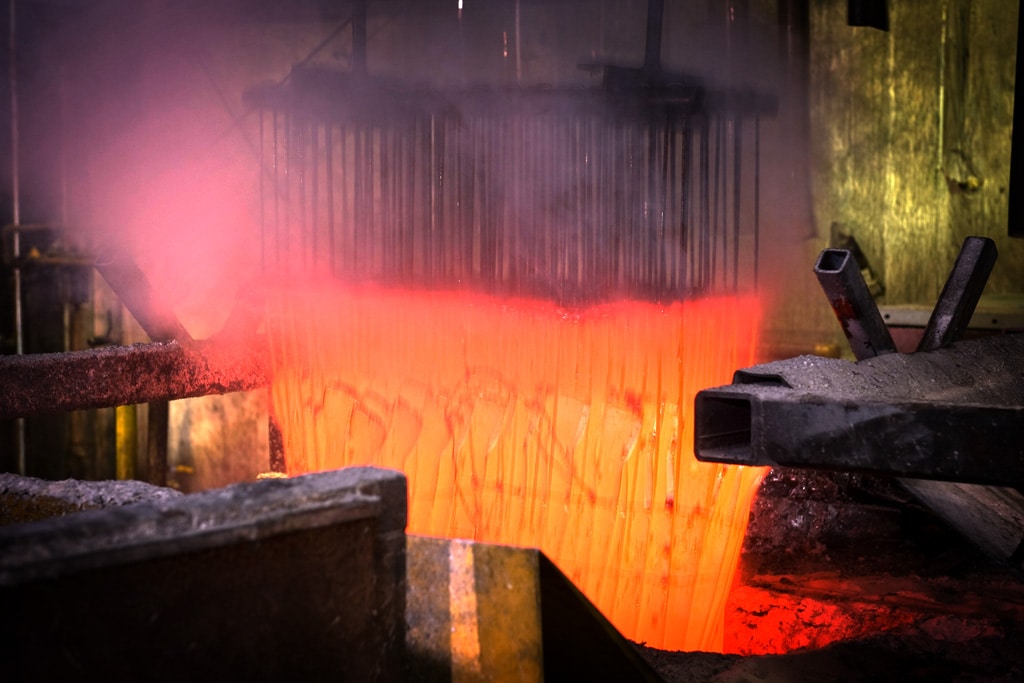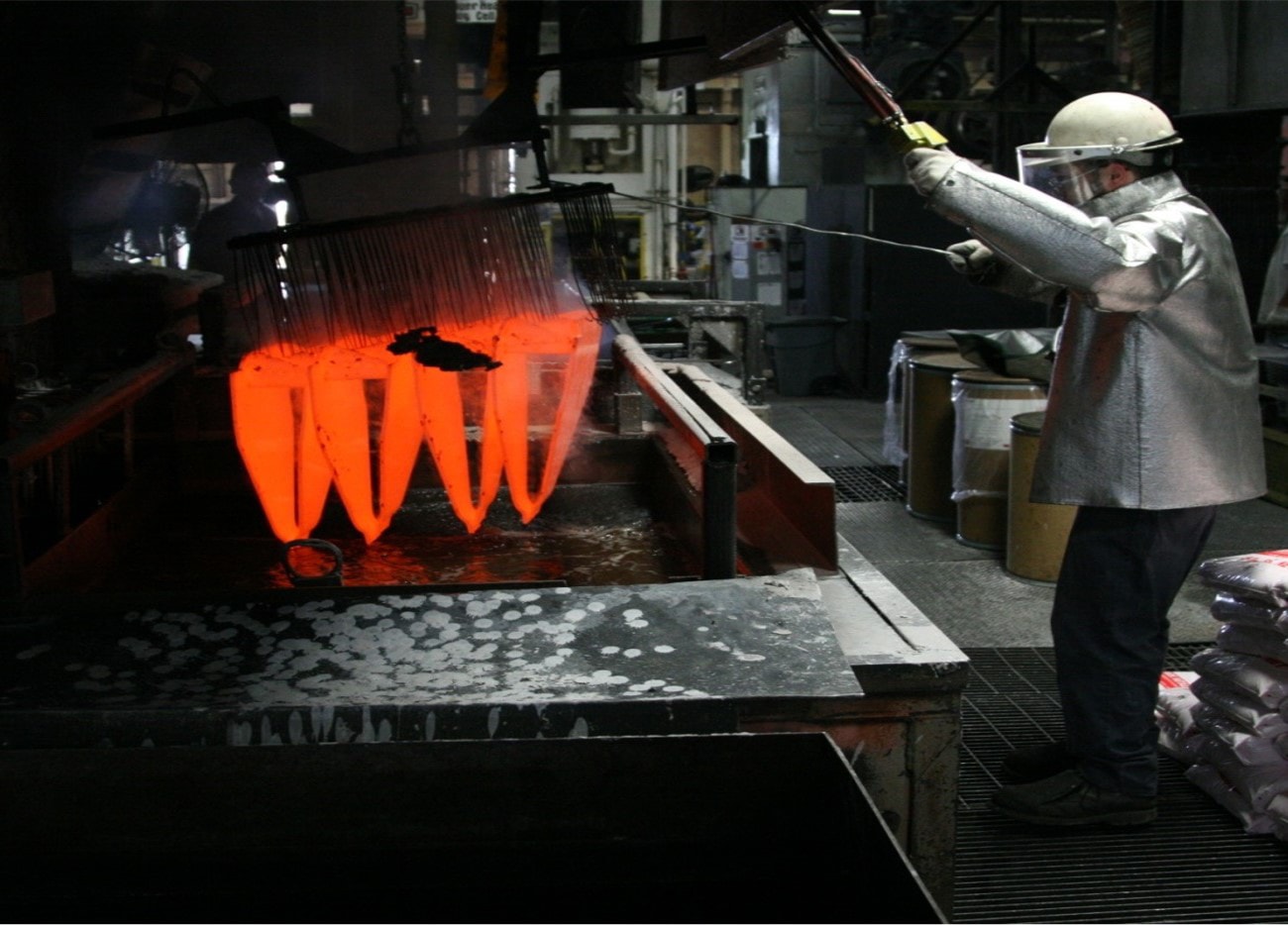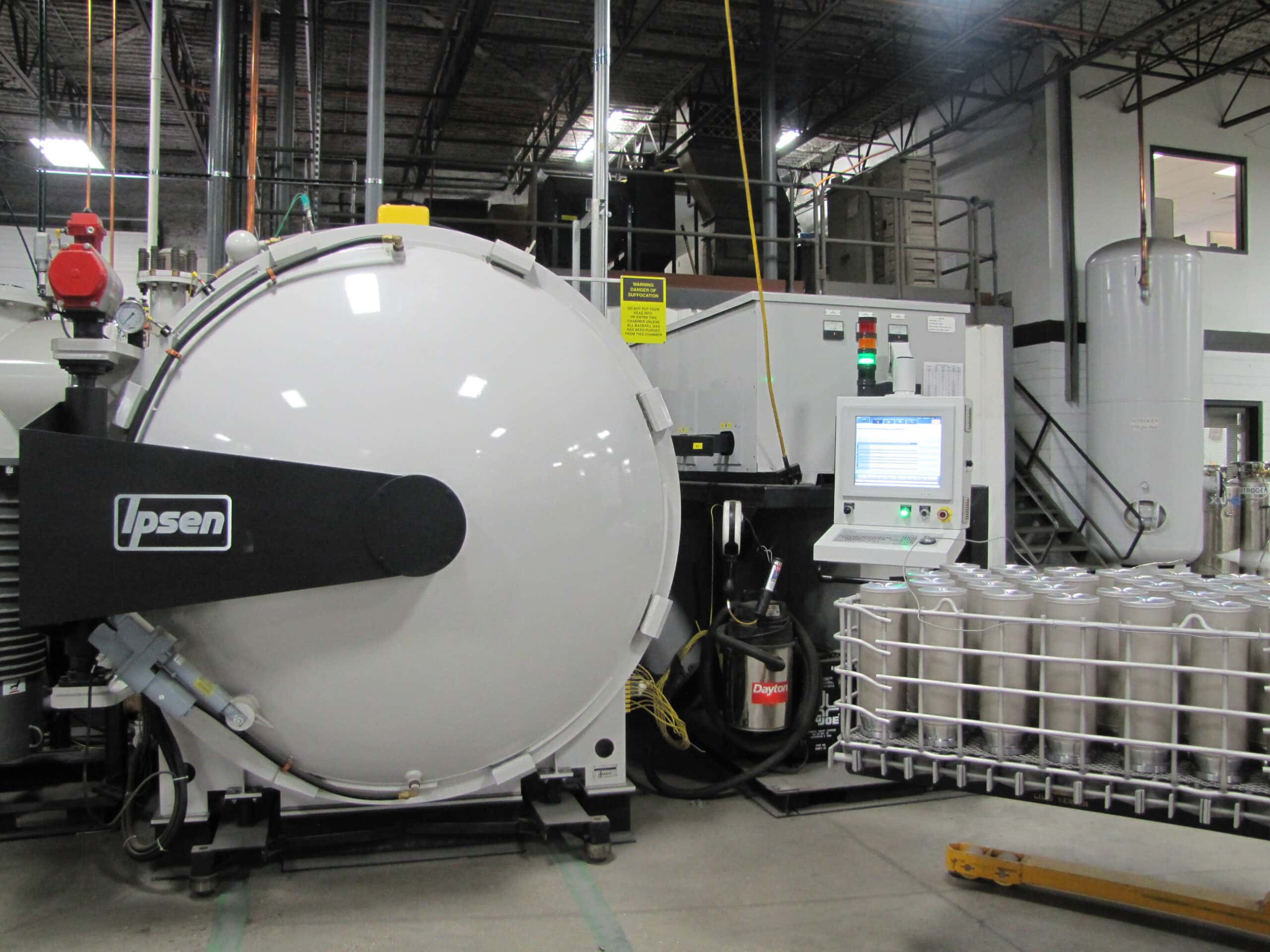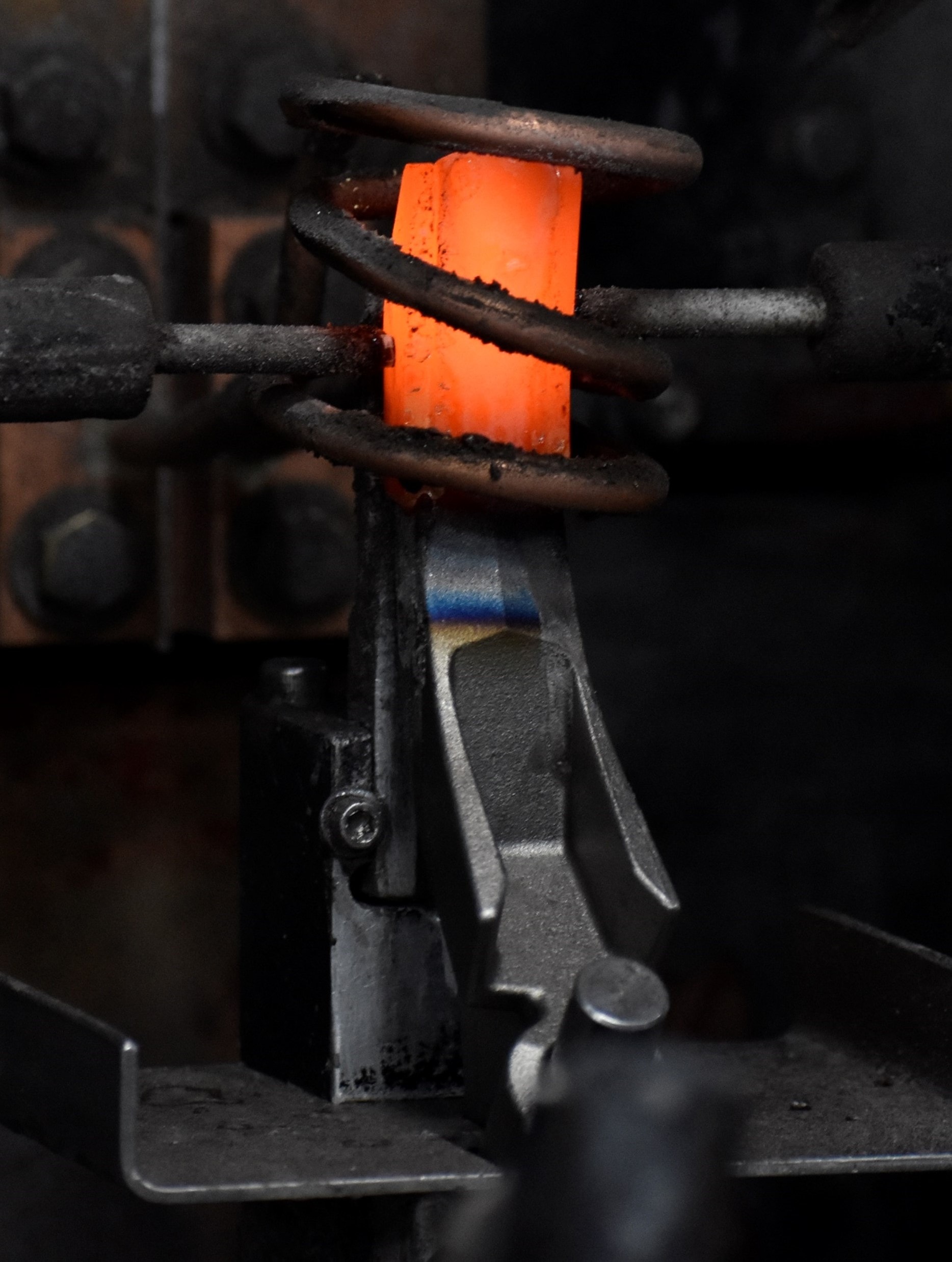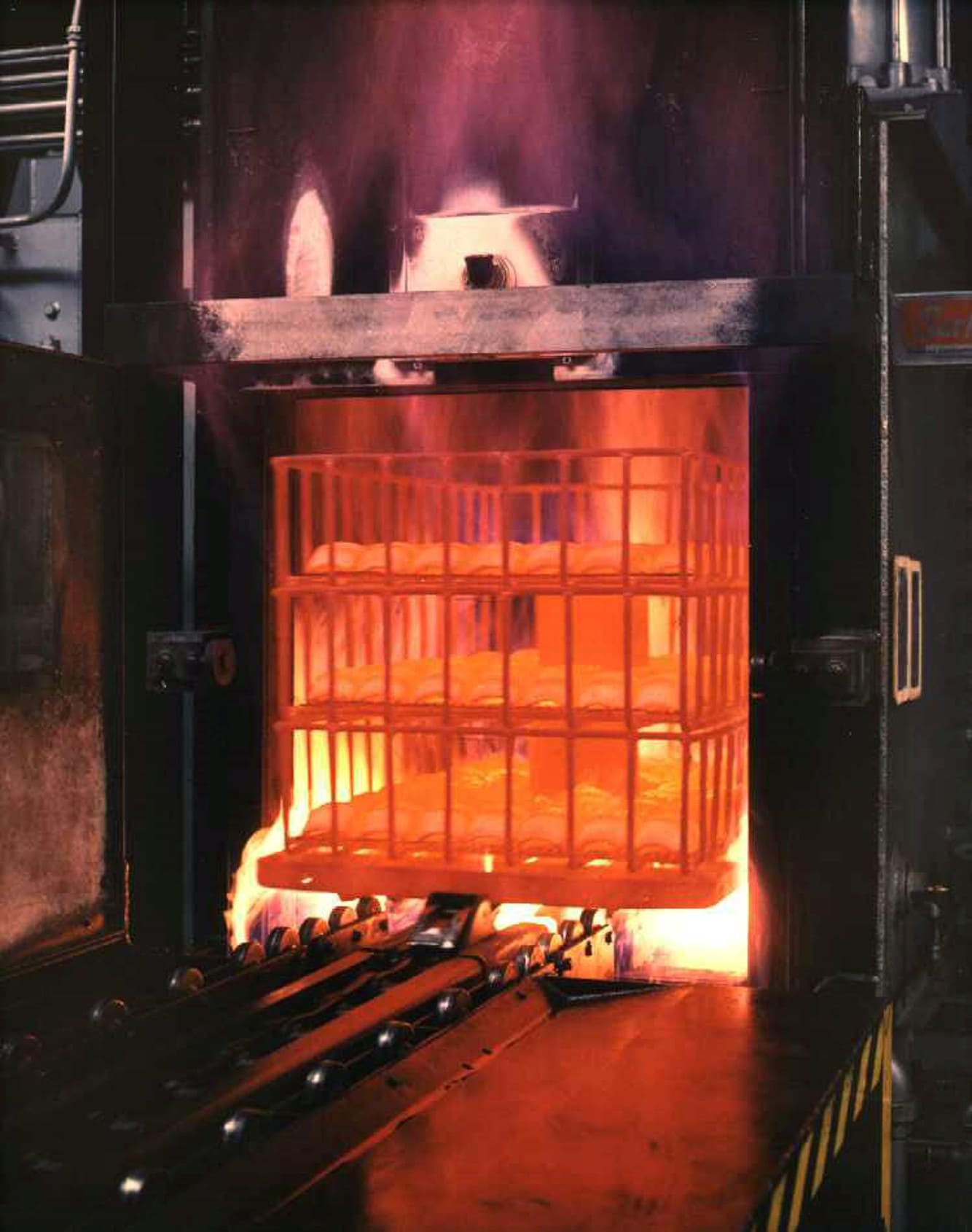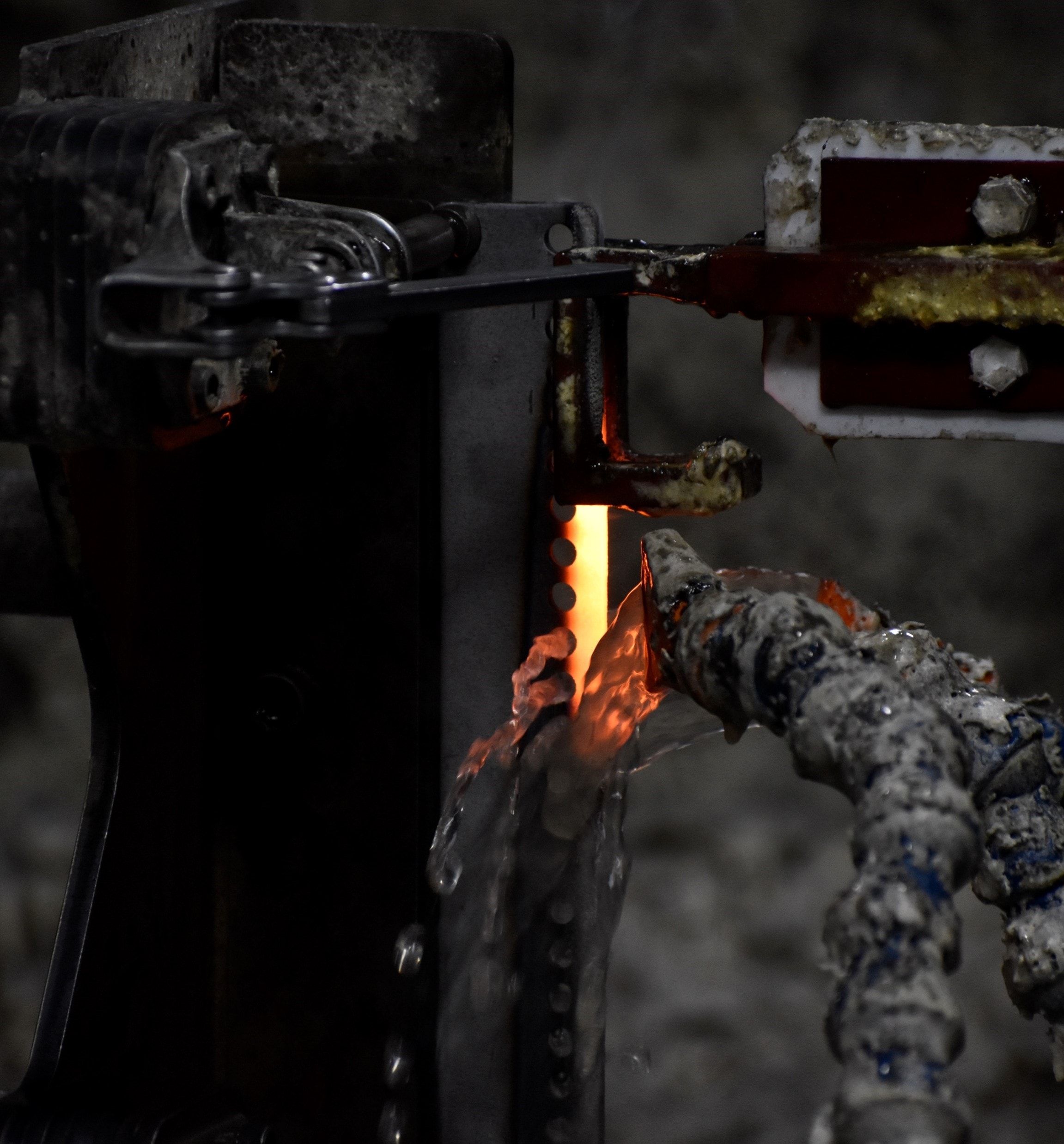Heat treat applications are an age-old process that improves strength, hardness, toughness, ductility, and corrosion resistance in metals. At Fisher Barton, heat treating applications is both science and art. It’s here that metallurgy is mastered through the application of world-class heat treatment resources to transform metal into products that last longer and perform better. Our state-of-the-art facilities boast cutting-edge automated systems that ensure precise control over temperature, atmosphere, and cooling rates, guaranteeing consistent and optimal outcomes. Complementing this automation is our team of skilled technicians and engineers who bring decades of expertise to the table, overseeing every aspect of the heat treatment process with meticulous attention to detail. Whether it’s harnessing the power of automation for large-scale projects or employing manual operations for intricate customization, Fisher Barton stands is dedicated to elevating the performance and durability of your components.
Austemper
Heat treating to provide uniform structure through out material and used to produce MARBAIN®
The Fisher Barton austempering process provides a solution to the expansion problems inherent with conventional quench and temper heat treating. Austempering produces its hardened structure (bainite) gradually and at a relatively high temperature, which provides many advantages. First, bainite’s slow nucleation and growth allows the transformation stresses to dissipate (20-minute bainitic reaction versus instantaneous martensitic reaction). Second, there is an increased plasticity resultant from the relatively high temperatures in the bainite transformation stages. Third, a smaller volume change is associated with the transformation to bainite. Further, bainite is more ductile than untempered martensite.
Enhanced Mechanical Properties: Austempering results in a fine-grained microstructure with improved mechanical properties such as higher toughness, ductility, and fatigue strength compared to conventional heat treatment methods. This makes components more durable and resistant to wear and impact.
Reduced Distortion and Warping: The controlled cooling process in Austempering minimizes the risk of distortion and warping in treated components, ensuring dimensional stability and maintaining tight tolerances, critical for precision applications.
Uniform Heat Treatment: Fisher Barton’s Austempering process ensures uniform heat treatment throughout the entire component, preventing inconsistencies or variations in material properties across different sections.
Improved Machinability: Components treated with Austempering exhibit improved machinability due to their refined microstructure, reducing tool wear and enhancing productivity during machining operations.
Environmentally Friendly: Austempering is a more environmentally friendly heat treatment process compared to some other methods, as it typically requires lower energy consumption and generates fewer emissions.
Cost-Effective Solution: Despite its advanced capabilities, Austempering can be a cost-effective solution for achieving superior mechanical properties in components, especially when considering the long-term benefits of increased durability and reduced maintenance.
Versatility in Material Compatibility: Fisher Barton’s Austempering process is compatible with a wide range of materials, including various grades of steel and alloys, offering flexibility in choosing the right material for specific applications.
Customized Solutions: Our experienced engineers work closely with clients to develop customized Austempering processes tailored to their specific requirements, ensuring optimal performance and quality in the finished components.
Increased Component Life: Austempering significantly increases the service life of components by enhancing their resistance to wear, fatigue, and corrosion, resulting in reduced downtime and maintenance costs.
Quality Assurance: At Fisher Barton, quality is paramount. Our Austempering process undergoes rigorous testing and inspection to ensure that components meet or exceed industry standards for performance, reliability, and consistency.
Fisher Barton offers enhanced mechanical properties, reduced distortion, uniform heat treatment, improved machinability, environmental friendliness, cost-effectiveness, material compatibility, customized solutions, increased component life, and stringent quality assurance, making it an excellent choice for optimizing the performance and longevity of metal components across various industries.
Annealing
Annealing is a heat treatment process that changes the properties of a material to increase ductility and reduce hardness by improving ductility and eliminating internal stress
Precision Temperature Control: Our annealing process is meticulously controlled to achieve precise temperatures, ensuring uniform heating and cooling for consistent results.
Customized Annealing Parameters: We tailor annealing parameters such as temperature, time, and cooling rates based on the specific material and desired properties, delivering bespoke solutions for each application.
State-of-the-Art Equipment: Fisher Barton employs advanced annealing equipment and techniques, including controlled atmosphere furnaces and automated systems, to maintain strict quality standards and optimize results.
Metallurgical Expertise: Our team of metallurgical experts possesses deep knowledge and experience in annealing techniques, allowing us to handle a wide range of materials and achieve desired material properties effectively.
Improved Mechanical Properties: Annealing enhances the ductility, toughness, and machinability of metals, resulting in components that are easier to form, machine, and work with during manufacturing processes.
Stress Relief: Annealing helps alleviate internal stresses within metals, reducing the risk of distortion, cracking, or failure, and ensuring long-term structural integrity of components.
Enhanced Microstructure: By refining the microstructure of metals, annealing improves grain structure, hardness, and overall material properties, leading to superior performance in demanding environments.
Optimized Performance: Annealed components exhibit improved fatigue resistance, wear resistance, and corrosion resistance, extending product lifespans and reducing maintenance costs.
Custom Solutions: Fisher Barton’s annealing capabilities are adaptable to various industries and applications, offering customized solutions to meet specific material requirements, tolerances, and performance criteria.
Vacuum Furnaces
Fisher Barton harnesses the power of advanced vacuum furnaces to deliver precise and effective heat treatment solutions for a diverse range of materials and applications. Heat treatment in a vacuum environment to provide no oxidation and lower porosity when used in FUSIONbond® process. Explore the features and benefits of our vacuum furnace capabilities:
Controlled Atmosphere: Our vacuum furnaces provide a controlled environment free of contaminants, ensuring consistent heat treatment results and preventing oxidation or decarburization of materials.
Uniform Heating and Cooling: With advanced temperature control and uniform heating throughout the furnace chamber, we achieve precise heat treatment profiles and minimize thermal gradients for superior material properties.
High-Temperature Capability: Fisher Barton’s vacuum furnaces can reach and maintain high temperatures, allowing for a wide range of heat treatment processes including annealing, hardening, tempering, and stress relieving.
Automated Systems: We utilize automated systems and advanced monitoring technologies to ensure accurate process control, real-time data analysis, and traceability throughout the heat treatment cycle.
Enhanced Material Properties: Our vacuum heat treatment processes result in improved material properties such as hardness, strength, ductility, and dimensional stability, meeting the most demanding performance requirements.
Minimized Distortion: The controlled heating and cooling rates in vacuum furnaces help minimize distortion and residual stresses in components, ensuring dimensional accuracy and preventing premature failures.
Clean and Uniform Surfaces: Vacuum environments eliminate surface contaminants and scale formation, leading to clean, bright, and uniform surfaces with improved corrosion resistance and aesthetics.
Consistent Quality: Fisher Barton’s vacuum furnaces offer consistent and repeatable heat treatment results, allowing for batch-to-batch consistency and reliable performance of heat-treated components.
Versatile Applications: From automotive parts to aerospace components, industrial tools, and beyond, our vacuum furnace capabilities are versatile and adaptable to a wide range of materials and industries.
Brazing (Carbide Inserts)
A heat treatment joining process that traditionally uses copper or nickel to adhere to dissimilar metals in which molten filler metal flows into the joint.
Brazing is a versatile joining process that offers a range of features and benefits, making it a preferred choice in various industries.
Versatility: Brazing can join a wide range of metals, including dissimilar metals, which may not be easily welded using other methods. This versatility makes it suitable for diverse applications in industries such as automotive, aerospace, electronics, and plumbing.
Strength and Durability: Brazed joints can exhibit high tensile strength, often approaching that of the base metals being joined. This results in durable and reliable connections that can withstand mechanical stresses and harsh operating conditions.
Hermetic Sealing: Brazing can create hermetic seals, making it ideal for applications requiring leak-tight joints, such as in refrigeration systems, vacuum devices, and medical equipment.
Temperature Control: Unlike welding, brazing operates at lower temperatures, reducing the risk of thermal distortion and minimizing the heat-affected zone (HAZ) in the base metals. This is particularly advantageous for joining heat-sensitive materials.
Precision and Cleanliness: Brazing allows for precise control over the joint area, producing clean and aesthetically pleasing connections with minimal distortion or discoloration. This is important for applications where visual appearance is a consideration.
Cost-Effective: Brazing often requires less equipment and energy compared to welding, making it a cost-effective joining method. Additionally, it can be automated for mass production, further enhancing efficiency and reducing labor costs.
Joining Dissimilar Materials: Brazing can join materials with different melting points or thermal expansions, expanding the range of materials that can be combined to create complex assemblies with diverse properties.
Repair and Restoration: Brazing can be used for repair and restoration purposes, allowing damaged or worn parts to be salvaged and returned to service without compromising performance.
Environmental Considerations: Brazing typically generates less fumes and spatter compared to welding, making it a cleaner and more environmentally friendly joining process.
Compatibility with Coatings: Brazing can be performed without adversely affecting surface coatings or finishes on the base materials, preserving the aesthetic and functional properties of the components.
Overall, brazing offers a combination of strength, versatility, precision, and cost-effectiveness, making it a valuable technique for a wide range of industrial applications where reliable and durable metal joints are essential.
Carburizing (Oil Quench & Temper)
Carburizing, specifically using the oil quench and temper method, is a heat treatment process primarily used to enhance the surface hardness and wear resistance of steel components. Oil is used to slow the cooling rate reducing the amount of distortion. Here are the key features and benefits of carburizing with oil quenching and tempering:
Surface Hardness: One of the primary benefits of carburizing with oil quenching is the significant increase in surface hardness. This is achieved by introducing carbon into the surface layers of the steel, forming a hardened case that can withstand abrasion and wear.
Wear Resistance: The hardened case created through carburizing and oil quenching improves the wear resistance of the steel component, making it suitable for applications subjected to friction, impact, and abrasive conditions.
Toughness and Ductility: Despite the increased hardness, the core of the steel retains its toughness and ductility. The tempering process following quenching helps to balance hardness with these properties, preventing brittleness and ensuring the component’s ability to withstand sudden shocks or loads.
Case Depth Control: Carburizing allows for precise control over the depth of the hardened case, enabling customization based on the specific requirements of the application. This flexibility ensures that the desired properties are achieved without compromising the core integrity of the component.
Improved Fatigue Strength: The combination of increased surface hardness and retained core toughness results in improved fatigue strength, making carburized components more resistant to cyclic loading and stress.
Dimensional Stability: Carburizing and oil quenching followed by tempering minimize distortion and dimensional changes in the component, ensuring dimensional stability and maintaining tight tolerances.
Corrosion Resistance: While primarily aimed at enhancing hardness and wear resistance, carburizing can also contribute to improved corrosion resistance, especially in components exposed to mild corrosive environments.
Versatility: Carburizing with oil quenching and tempering is suitable for a wide range of steel grades and component geometries, making it a versatile heat treatment process for various industries such as automotive, aerospace, machinery, and tooling.
Cost-Effectiveness: Compared to some other surface hardening methods, carburizing with oil quenching and tempering can be a cost-effective solution for achieving desired material properties, especially when considering the balance between performance and production costs.
Consistency and Quality: When performed with precision and adherence to strict process parameters, carburizing with oil quenching and tempering ensures consistent and high-quality results, meeting or exceeding industry standards for performance and reliability.
Carburizing with oil quenching and tempering offers a combination of enhanced surface hardness, wear resistance, toughness, and dimensional stability, making it a preferred choice for achieving durable and high-performance steel components in demanding applications.
Induction
A localized heat treatment controlled by heating and cooling of a metal or alloy in order to obtain a set of desired metallurgical properties.
Induction heat treatment is a specialized method of heating and treating metal components using electromagnetic induction. It offers several features and benefits that make it a preferred choice in various industries. Here are the key features and benefits of induction heat treatment:
Precise and Controlled Heating: Induction heating allows for precise and localized heating of specific areas of a component, minimizing heat-affected zones (HAZ) and providing better control over the heating process. This precision results in uniform heating and consistent material properties across the treated areas.
Rapid Heating and Cooling Rates: Induction heat treatment can achieve rapid heating and cooling rates, leading to shorter cycle times and increased production efficiency. This is particularly advantageous for high-volume manufacturing environments.
Energy Efficiency: Compared to traditional heating methods such as gas or furnace heating, induction heating is more energy-efficient because it directly heats the material without heating the surrounding environment. This can lead to reduced energy consumption and lower operating costs.
Customization and Flexibility: Induction heat treatment offers flexibility in terms of process parameters, allowing for customization based on the specific material, component geometry, and desired material properties. It can be adapted to treat a wide range of metals and alloys.
Controllable Heating Depths: By adjusting the frequency and power of the induction heating, it is possible to control the depth of heat penetration into the material. This enables selective heating of surface layers or precise hardening of localized areas as needed.
Improved Material Properties: Induction heat treatment can enhance various material properties such as hardness, wear resistance, fatigue strength, and metallurgical structure. It can also improve surface finish and reduce residual stresses in components.
Minimal Distortion and Warping: The localized heating and rapid cooling characteristics of induction heat treatment help minimize distortion, warping, and metallurgical changes in the base material. This is beneficial for maintaining tight tolerances and dimensional accuracy in finished components.
Environmentally Friendly: Induction heating generates minimal emissions and waste compared to some other heat treatment methods, making it a more environmentally friendly option. It also eliminates the need for heating gases or open flames, reducing the risk of workplace hazards.
Consistency and Reproducibility: Induction heat treatment processes can be automated and controlled with precision, ensuring consistent and repeatable results from batch to batch. This consistency is essential for meeting quality standards and specifications.
Versatility in Applications: Induction heat treatment is used in a wide range of applications across industries such as automotive, aerospace, manufacturing, and tooling. It can be applied for surface hardening, case hardening, annealing, tempering, and other heat treatment processes.
Induction heat treatment offers precise and controlled heating, rapid cycle times, energy efficiency, customization, improved material properties, minimal distortion, environmental benefits, consistency, and versatility, making it a highly effective and preferred method for enhancing the performance and durability of metal components.
Cryo
Cryo or cold quenching heat treatment is a specialized process that involves cooling materials to extremely low temperatures after heating, typically using liquid nitrogen or other cryogenic mediums. Cold Quenching method to increase the toughness and transform austenite to martensite. This treatment offers unique features and benefits that make it valuable in various industrial applications. Here are the key features and benefits of cryo or cold quenching heat treatment:
Enhanced Hardness and Strength: Cryo treatment significantly enhances the hardness and strength of materials, especially metals and alloys. The cold quenching process stabilizes the microstructure of the material, resulting in improved mechanical properties such as wear resistance, toughness, and fatigue strength.
Reduced Residual Stresses: Cryo treatment helps relieve residual stresses that may be present in materials after conventional heat treatment processes. This leads to improved dimensional stability and reduced risk of distortion or warping in finished components.
Increased Wear Resistance: The enhanced hardness and stability achieved through cryo treatment make materials more resistant to wear, abrasion, and surface damage. This is beneficial in applications where components are subjected to high-friction or abrasive conditions.
Fine Grain Structure: Cryo treatment promotes the formation of a fine grain structure in materials, which can improve their overall mechanical properties and performance. Fine-grained materials often exhibit higher strength and toughness compared to coarse-grained counterparts.
Improved Machinability: Cryo treatment can improve the machinability of certain materials, making them easier to cut, drill, and machine without excessive tool wear. This can result in cost savings and increased productivity in machining operations.
Stress Relief: Cryo treatment is effective in relieving internal stresses in materials, which can occur due to manufacturing processes or previous heat treatments. This stress relief can prevent premature failure and increase the longevity of components.
Thermal Stability: Materials treated with cryo quenching demonstrate improved thermal stability, maintaining their mechanical properties even at elevated temperatures. This is important for applications involving thermal cycling or exposure to fluctuating temperatures.
Consistency and Reproducibility: Cryo treatment processes can be precisely controlled and repeated with consistency, ensuring uniform results across batches. This consistency is essential for meeting quality standards and specifications in manufacturing.
Extended Tool Life: Cryo treatment is often used to enhance the performance and lifespan of cutting tools, dies, molds, and other industrial equipment. The increased hardness and wear resistance can significantly extend tool life, reducing downtime and replacement costs.
Versatility: Cryo or cold quenching heat treatment is applicable to a wide range of materials, including steels, alloys, plastics, and composites. It can be used in various industries such as automotive, aerospace, tooling, electronics, and manufacturing.
Cryo or cold quenching heat treatment offers enhanced hardness, strength, wear resistance, machinability, stress relief, thermal stability, consistency, and versatility, making it a valuable tool for improving the performance, durability, and reliability of materials and components in diverse industrial applications.



